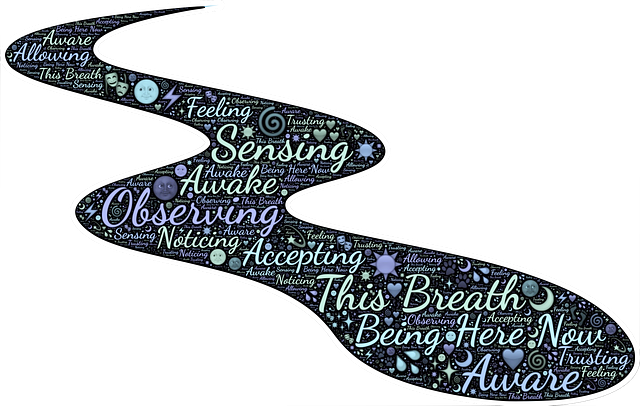The upgrade version of the Nature Summit provides a number of meditation podcasts that offer a range of guided meditations. In one of these, Mark Coleman – meditation teacher, coach, and therapist – leads a guided meditation on the Mindfulness of Breathing. This is one of three meditations that he offers as an upgrade bonus that normally make up his CD meditation series, The Art of Mindfulness: Meditations for Awareness, Insight, Relaxation and Peace. Mark is a co-founder of The Mindfulness Training Institute and the Nature Summit.
A guided meditation on the mindfulness of breathing
Mark’s meditation on breathing begins with encouraging you to adopt a comfortable position and become conscious of the pressure of your feet on the floor.
He then provides a series of mindfulness activities designed to heighten awareness of breathing and its beneficial effects on mind and body. His instructions for this mindful breathing practice are below:
- Begin with a light body scan checking for, and releasing, any point of tension. You can scan the more common places of tension – your shoulders, neck muscles, face and eye muscles, feet and ankles. I find that typically my shoulders are raised and tense, so I have to learn to let go at this stage of the meditation.
- You can now focus on an area of your body where you can sense your breathing – it could be the flow of air in and out of your nose, the undulation of your chest or the rise and fall of your abdomen. Try to pay attention to your breath and how you are experiencing it – fast or slow, deep or shallow, long or short. The idea is not to try to control your breath but just observe how it is for you.
- Mark suggests that once you have been able to focus on a location of your experience of breathing that you take time to pay full attention to the in-breath and then the out-breath – just focusing on how they are occurring.
- You can then move on to observing the gap or silence between your in-breath and your out-breath – lengthening the gap if you desire. Mark notes that during this stage of the breathing meditation (or one of the earlier stages) it is normal to be beset with distractions from your focus on breathing – images, emotions, planning, questioning, going over the past or thinking about the future. He suggests that when you notice a distraction, name it for what it is without self-criticism and return to your focus. He maintains that noticing the distraction and its nature in the moment is actually an act of mindfulness (paying attention on purpose in the present moment and doing so non-judgmentally). By naming the type of distraction, you may actually observe a pattern in your distracted thinking (mine is typically “planning”).
- If strong bodily sensations arise, you can put attention on breath in the background while you deal with the sensation such as pain, tingling or soreness. Similarly, if a strong emotion occurs, you can temporarily focus on it, name the emotion, and explore its bodily manifestation. Mark suggests that you avoid letting your thinking about the emotion take over but stick with its actual physical manifestation. Thoughts can reinforce an emotion, embed it more deeply and make it difficult to return to your focus on breathing.
Variations on the theme of mindfulness of breathing
Richard Wolf, author of In Tune: Music as the Bridge to Mindfulness, discusses the practice of “rhythmic breathing” when exploring the interplay between music and mindfulness. He also offers several breathing practices that involve breathing in-time to music beats such as 4/4 or ¾ time. He suggests that you can develop this further by adopting what he calls the “four-bar sequence” – basically alternating inhalation and exhalation with holding your breath and doing each aspect for the equivalent of four bars.
Richard encourages us to not only observe our breathing closely but notice its sonic qualities as well. He maintains that the process of conscious breathing is a meditative practice that builds mindfulness. He argues that regular practice of breathing meditation linked to music can help us to develop “deep listening”, a skill that underpins quality relationships.
Reflection
Our breath is with us in every moment and by paying attention to our breathing in the ways suggested, we can become more grounded in the present and less disturbed by ups and downs of life. As we grow in self-awareness through breathing meditations, we can deepen our self-awareness and emotional regulation and being more fully present to others through improved concentration and deep listening.
Mark extends the practice of mindful breathing and deep listening beyond our room to outside in nature and the wild. He offers free daily nature meditations as well as Awake in the Wild Teacher Training. He is the author of A Walk in the Wild: A Buddhist Walk through Nature – Meditations, Reflections and Practices.
_____________________________
Image by John Hain from Pixabay
By Ron Passfield – Copyright (Creative Commons license, Attribution–Non Commercial–No Derivatives)
Disclosure: If you purchase a product through this site, I may earn a commission which will help to pay for the site, the associated Meetup group, and the resources to support the blog.
